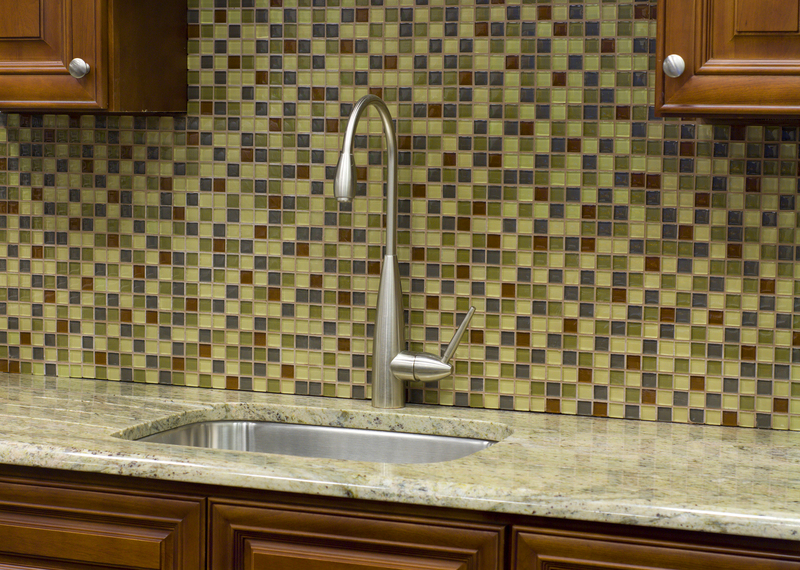Home Carpet and Floor Revival
Posted on 03/06/2025
Home Carpet and Floor Revival: Refreshing Your Surfaces for a Beautiful Home
Are your carpets looking tired, or your hard floors losing their luster? A well-executed home carpet and floor revival can transform any living space, dramatically enhancing comfort, appearance, and even property value. In this comprehensive guide, we'll walk you through the most effective ways to revive carpets and floors--restoring them to their former glory and keeping them looking beautiful for years to come.

Why Invest in Carpet and Floor Revival?
When it comes to home improvement, carpets and floors are often overlooked. Yet, they form the foundation of every room's ambiance and comfort. Regular upkeep isn't always enough; sometimes a deeper floor and carpet restoration is necessary for achieving truly stunning results.
- Healthier Living Spaces: Revived flooring eliminates allergens, dust, and bacteria.
- Enhanced Home Appeal: Fresh, clean surfaces dramatically improve visual aesthetics.
- Increased Longevity: Proper maintenance extends the life-span of your flooring investment.
Common Signs Your Carpets and Floors Need Revival
- Stubborn stains that resist regular cleaning.
- Brittle, matted, or worn-out fibers in carpeted areas.
- Visible scratches, scuffs, or dull patches on hardwood, laminate, or vinyl floors.
- Unpleasant odors that linger even after cleaning.
- Creaky, uneven, or loose floorboards.
How to Revive Carpets: Step-by-Step Guide
A home carpet revival doesn't always require replacing your carpets. In most cases, a mix of deep cleaning, spot treatment, and professional care brings worn carpets back to life.
1. Deep Cleaning for Carpets
Vacuuming removes surface dirt, but a deep clean extracts embedded debris, refreshes fibers, and eliminates allergens. Consider these options:
- Steam Cleaning: Uses high-temperature water vapor to sanitize and lift grime.
- Shampooing: Involves specialized carpet shampoos with rotary brushes.
- Dry Cleaning: Employs minimal moisture, ideal for delicate or natural-fiber carpets.
2. Spot Treatment for Stains
Stubborn stains often demand targeted treatments, especially for wine, pet accidents, or coffee spills. Effective methods include:
- Enzyme Cleaners: Particularly effective for organic stains (e.g., pet urine).
- Homemade Solutions: Try a mix of white vinegar, baking soda, and water for general stains.
- Professional Spot Cleaners: Hire certified technicians for tough or set-in blemishes.
3. Deodorizing and Freshening
Unpleasant smells linger without proper treatment. Sprinkle baking soda over the carpet, let sit for 30-60 minutes, then vacuum. For persistent odors, steam cleaning is often the most effective carpet deodorizing technique.
4. Restoring Carpet Pile and Texture
High-traffic zones can flatten carpet pile, making it look old and worn. To revive carpet fibers:
- Use a carpet rake or brush to lift and separate tangled fibers.
- Apply a damp towel and steam iron (on low) to re-fluff matted areas--always patch-test first!
5. Professional Carpet Revival Services
If DIY methods don't achieve the desired results, it's time for expert carpet restoration. Professionals have specialized equipment for deep extraction, odor removal, and even re-stretching to eliminate wrinkles or bunching.
Hard Floor Revival: Restoring Wood, Tile, and More
Whether you have hardwood, tile, laminate, or vinyl, regular maintenance and periodic rejuvenation are essential for a lasting, attractive finish. Hard floor revival brings back shine, protects surfaces, and addresses deeper wear and tear.
1. Cleaning Away Grime and Buildup
Start by thoroughly sweeping and vacuuming. Mop with a gentle, flooring-appropriate cleaner. For heavily soiled floors, consider the following:
- Hardwood: Use pH-neutral products, never excessive water.
- Tile: Clean grout lines with a paste of baking soda and water, scrub with a brush, and wipe floors with a vinegar-based solution.
- Laminate/Vinyl: Avoid soaking, use a microfiber mop with appropriate cleaners.
2. Polishing and Protecting Hard Floors
After cleaning, revived floors often benefit from polishing or sealing:
- Hardwood Polishing: Apply a dedicated wood floor polish to restore shine and provide a protective layer. Always follow the manufacturer's instructions.
- Tile Sealing: Especially for natural stone or porous ceramic tiles, sealers protect against stains and damage.
- Vinyl and Laminate Restoration: Use rejuvenating solutions designed to add luster and resist scuffs.
3. Repairing Surface Damage
For scratched hardwood or chipped tiles, a true home floor revival may require targeted repairs:
- For hardwood scratches, use a stain-filled marker or wood filler for minor damage. For deeper gouges, consider professional sanding and refinishing.
- Cracked or chipped tiles can be replaced individually by a handy homeowner or tiling expert.
- Laminates with minor scuffs can be touched up with repair kits, but significant swelling or warps might need plank replacement.
4. Reviving the Grout
A dingy grout line can make an entire floor look tired. Restore grout by:
- Scrubbing with hydrogen peroxide or an oxygen bleach paste.
- Applying a grout recoloring sealant for a like-new appearance.
5. Professional Floor Revival Services
For floors with serious wear or specialty finishes, professional refinishing is the best way to achieve a flawless, long-lasting result. Sanding, buffing, and re-coating should always be handled by experienced technicians.
DIY vs. Professional Carpet and Floor Revival
Both DIY and professional options have their place in home carpet and floor cleaning and restoration. Consider these factors when deciding the right approach:
- DIY: Budget-friendly for regular upkeep and minor issues. Ideal for individuals comfortable using cleaning equipment and following safety instructions.
- Professional: Recommended for deep-set stains, extensive damage, specialty surfaces, or when preparing to sell your home.
Tip: A combination of regular DIY maintenance and occasional professional deep cleaning delivers the best results for most homes!
Cost Considerations
- DIY carpet and floor revival typically involves the cost of cleaning products, equipment rental (like steam cleaners), and possibly minor repair kits.
- Professional services range widely in price depending on area size, level of soiling, and required repair work.
How Often Should You Revive Your Carpets and Floors?
- Carpets: Vacuum 1-2 times weekly; deep clean semi-annually or as needed.
- Hardwood/Tile/Vinyl: Sweep/mop weekly; polish or deep clean every 3-6 months; professional refinishing every few years.
Long-Term Maintenance Tips: Keep Floors and Carpets Looking New
Once you've achieved a carpet and floor revival, take steps to prolong your hard work and keep surfaces looking fresh:
- Place doormats at every entrance to capture dirt before it reaches your floors.
- Establish a no-shoe policy indoors to minimize abrasion and staining.
- Vacuum and sweep frequently--dirt is the enemy of carpet fibers and floor finishes alike.
- Address spills and stains immediately!
- Use protective pads under furniture to prevent indentations, especially on carpet and hardwood.
- Maintain appropriate humidity levels to prevent hardwood warping or splitting of floor finishes.
Smart home habits and regular care can prevent the need for major home carpet and floor restoration projects in the future.
A proactive approach makes maintenance easier and keeps your living space healthy and inviting.

Choosing the Best Carpet and Floor Revival Products
The right cleaning and restoration products make all the difference. Always select options that match your specific materials, and when in doubt, test in an inconspicuous area first.
- For eco-friendly home cleaning, look for biodegradable, non-toxic ingredients safe for pets and children.
- Professional-grade solutions offer stronger performance for tough jobs, but always follow safety guidelines.
- Invest in high-quality equipment--reliable vacuums, steam cleaners, and microfiber mops enhance results and save time.
Final Thoughts: The Rewards of Carpet and Floor Revival
A transformative carpet and floor revival uplifts not just your home's appearance, but the overall quality of your living environment. Fresh, clean carpets welcome bare feet and enhance warmth. Shining, damage-free floors create a sense of order, spaciousness, and pride of ownership. By following the tips and steps in this guide, you'll not only rejuvenate your flooring but also safeguard your investment for the long term.
Ready to embark on your home carpet and floor revival journey? Whether you DIY or seek professional help, revitalized floors and carpets are just a few steps away from transforming your home into the welcoming haven you deserve.
Frequently Asked Questions (FAQs)
- Q: How do I know if my carpet needs to be replaced instead of revived?
A: Consider replacement if your carpet is excessively worn, has permanent odors, or if deep cleaning and restoration services no longer make a noticeable difference. - Q: Can I use the same cleaning products on all types of floors?
A: No, always use products formulated specifically for your type of flooring to avoid damage. - Q: How quickly will I see results?
A: Many DIY methods provide immediate visual improvement, but it may take a full cleaning and drying cycle for the best results--especially with deep cleans or professional restoration.
Don't wait to enjoy the benefits of a fresh, revitalized home! Start your home carpet and floor revival journey today, and step into a cleaner, more beautiful living space.




